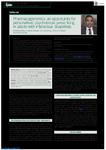Pharmacogenomics: an opportunity for personalised psychotropic prescribing in adults with intellectual disabilities
| dc.contributor.author | Perera, Bhathika | |
| dc.contributor.author | Steward, C | |
| dc.contributor.author | Courtenay, K | |
| dc.contributor.author | Andrews, T | |
| dc.contributor.author | Shankar, Rohit | |
| dc.date.accessioned | 2022-08-17T14:19:36Z | |
| dc.date.available | 2022-08-17T14:19:36Z | |
| dc.date.issued | 2022-09 | |
| dc.identifier.issn | 2056-4724 | |
| dc.identifier.issn | 2056-4724 | |
| dc.identifier.other | e157 | |
| dc.identifier.uri | http://hdl.handle.net/10026.1/19544 | |
| dc.description.abstract |
<jats:title>Summary</jats:title> <jats:p>There is growing evidence for the use of pharmacogenomics in psychotropic prescribing. People with intellectual disabilities are disproportionately prescribed psychotropics and are at risk of polypharmacy. There is an urgent need for safeguards to prevent psychotropic overprescribing but it is equally crucial that this population is not left behind in such exciting initiatives. Understanding how genetic variations affect medications is a step towards personalised medicine. This may improve personalised prescribing for people with intellectual disabilities, especially given the high rate of psychiatric and behavioural problems in this population. Our editorial explores opportunities and challenges that pharmacogenomics offers for the challenges of polypharmacy and overprescribing of psychotropics in people with intellectual disabilities.</jats:p> | |
| dc.format.extent | e157- | |
| dc.format.medium | Electronic | |
| dc.language | en | |
| dc.language.iso | en | |
| dc.publisher | Royal College of Psychiatrists | |
| dc.rights | Attribution 4.0 International | |
| dc.rights.uri | http://creativecommons.org/licenses/by/4.0/ | |
| dc.subject | Intellectual disabilities | |
| dc.subject | genetics | |
| dc.subject | polypharmacy | |
| dc.subject | psychotropics | |
| dc.subject | discrimination | |
| dc.title | Pharmacogenomics: an opportunity for personalised psychotropic prescribing in adults with intellectual disabilities | |
| dc.type | journal-article | |
| dc.type | Journal Article | |
| plymouth.author-url | https://www.webofscience.com/api/gateway?GWVersion=2&SrcApp=PARTNER_APP&SrcAuth=LinksAMR&KeyUT=WOS:000841325000001&DestLinkType=FullRecord&DestApp=ALL_WOS&UsrCustomerID=11bb513d99f797142bcfeffcc58ea008 | |
| plymouth.issue | 5 | |
| plymouth.volume | 8 | |
| plymouth.publication-status | Published | |
| plymouth.journal | BJPsych Open | |
| dc.identifier.doi | 10.1192/bjo.2022.554 | |
| plymouth.organisational-group | /Plymouth | |
| plymouth.organisational-group | /Plymouth/Faculty of Health | |
| plymouth.organisational-group | /Plymouth/Users by role | |
| dc.publisher.place | England | |
| dc.identifier.eissn | 2056-4724 | |
| dc.rights.embargoperiod | Not known | |
| rioxxterms.versionofrecord | 10.1192/bjo.2022.554 | |
| rioxxterms.licenseref.uri | http://creativecommons.org/licenses/by/4.0/ | |
| rioxxterms.type | Journal Article/Review |



